Janelle Monae Hidden Figures
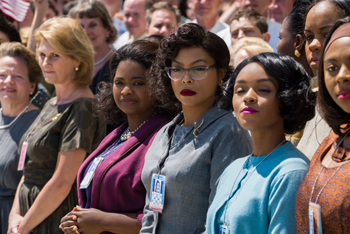
Janelle Monae Hidden Figures
Cast: Kevin Costner, Kirsten Dunst, Taraji P. Henson, Octavia Spencer, Janelle Monae
Director: Theodore Melfi
Genre: Drama
Rated: PG
Running Time: 127 minutes
Synopsis: A team of African-American women provide NASA with important mathematical data needed to launch the program's first successful space missions.
Hidden Figures
Release Date: February 16th, 2017
About The Production
'Yes, they let women do some things at NASA...."
Hidden Figures uncovers the incredible, untold yet true story of a brilliant group of women who changed the foundations of the country for the better -- by aiming for the stars. The film recounts the vital history of an elite team of black female mathematicians at NASA who helped win the all-out space race against America's rivals in the Soviet Union and, at the same time, sent the quest for equal rights and opportunity rocketing forwards.
Everyone knows about the Apollo missions. We can all immediately list the bold male astronauts who took those first giant steps for humankind in space: John Glenn, Alan Shepard and Neil Armstrong. Yet, remarkably, Katherine G. Johnson, Dorothy Vaughan and Mary Jackson's are names not taught in school or even known to most people -- even though their daring, smarts and powerful roles as NASA's ingenious 'human computers" were indispensable to advances that allowed for human space flight.
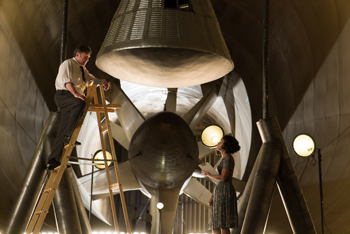 At last, the story of a visionary trio of women who crossed gender, race and professional lines on their way to pioneering cosmic travel comes to the screen starring Oscar®-nominee Taraji P. Henson (Empire, Benjamin Button, Hustle And Flow), Academy Award® winner Octavia Spencer (Allegiant, Fruitvale Station, The Help), singer Janelle Monáe making her motion picture debut and two time Oscar® winner Kevin Costner (Black Or White, Field Of Dreams, Dancing With Wolves).
At last, the story of a visionary trio of women who crossed gender, race and professional lines on their way to pioneering cosmic travel comes to the screen starring Oscar®-nominee Taraji P. Henson (Empire, Benjamin Button, Hustle And Flow), Academy Award® winner Octavia Spencer (Allegiant, Fruitvale Station, The Help), singer Janelle Monáe making her motion picture debut and two time Oscar® winner Kevin Costner (Black Or White, Field Of Dreams, Dancing With Wolves). Director Theodore Melfi (St. Vincent) brings the women's rise to the top ranks of aerospace in the thrilling early days of NASA to life via a fast-moving, humour-filled, inspiring entertainment that illuminates both the gutsy quest for Earth's first, seemingly impossible orbital flight and also the powerful things that can result when women unite.
For all its joys and triumphs, Hidden Figures is also a film that takes place at the crossroads of the most defining struggles in American history: the evolving fight for Civil Rights; the battle to win the high-stakes Cold War without risking nuclear war and be the first superpower to establish a human presence outside planet Earth; and the ongoing drive to show how the mind-boggling technological breakthroughs that create the world's future have nothing to do with gender or background.
Says Theodore Melfi: 'This story takes place at the collision of the Cold War, the space race, the Jim Crow south, and the birth of the Civil Rights movement. It is incredible territory for a rich and powerful story few people know about at all."
Adds Taraji P. Henson: 'Now we know there were amazing women behind how John Glenn came to orbit the earth in space - we finally get to hear their story."
Touchingly, Katherine G. Johnson, now in her 90s, finds the growing fascination with her life's work and that of her fellow compatriots a surprise as she says she was always just doing her best for her job, her family and her community, as she believes anybody would. 'I was just solving problems that needed to be solved," she says with characteristic modesty.
As for what she advises people facing challenges today, Katherine G. Johnson says: 'Stick with it. No matter the problem, it can be solved. A woman can solve it -- and a man can too, if you give him a lot of time."
Fox 2000 Pictures Presents A Chernin Entertainment / Levantine Films Production, Hidden Figures, directed by Theodore Melfi from a screenplay by Allison Schroeder and Theodore Melfi, based on the book by Margot Lee Shetterly. The producers are Donna Gigliotti, Peter Chernin, Jenno Topping, Pharrell Williams and Theodore Melfi and the executive producers are Jamal Daniel, Renee Witt, Ivana Lombardi, Mimi Valdés, Kevin Halloran and Shetterly.
Joining Henson, Spencer, Monáe and Costner is a cast that includes Emmy nominated Mahershala Ali (Free State Of Jones, House Of Cards), Emmy nominated Kirsten Dunst (Fargo, Spiderman, Mona Lisa Smile), four time Emmy winner Jim Parsons (The Big Bang Theory, The Normal Heart) and Kimberly Quinn (St. Vincent, Gypsy). The behind-the-scenes creative team includes director of photography Mandy Walker (Jane Got A Gun, Australia), production designer Wynn Thomas (Grudge Match, Cinderella Man, A Beautiful Mind), editor Peter Teschner (St. Vincent, Identity Thief), costume designer Renée Erlich Kalfus (Annie, Friends With Benefits, Chocolat) and composers Hans Zimmer, Pharrell Williams and Benjamin Wallfisch.
Meet NASA's 'Human Computers"
Few accomplishments in American history have been as celebrated as the nation's space program and those first soaringly idealistic journeys to take humankind into the cosmos we'd contemplated since history's dawn. President Kennedy has been hailed for galvanising the country to dream big; the astronauts who flew the perilous early flights into the unknown have become icons; and the meticulous male NASA engineers at mission control have been lauded for their grit and tenacity under pressure.
Yet there remain unsung and unlikely heroes of the space race – particularly, a team of female mathematicians who blazed multiple trails, trails towards greater diversity in science, equality in America, for human mathematical achievement and to launch John Glenn into mesmerizing orbit at more than17, 000 miles per hour as he circled three times around the globe in space.
It was a time in the country when opportunities could seem unjustly limited – that was true if you were a woman, if you were African-American, and especially if you were an African-American woman. Yet these dazzlingly smart NASA women flouted the limitations without fanfare, redefining the entire idea of what was possible – and who is vital to the nation -- by proving themselves absolutely essential to America's future.
For Katherine G. Johnson, Dorothy Vaughan and Mary Jackson, the chance to use their knowledge, passion and skills opened up just as the demands of World War II were shifting the nation's social fabric. On the factory front, women were suddenly invited to become Rosie the Riveters. Less famously, the same thing was happening in science and math. Faced with a daunting shortage of male scientists and mathematicians and with new laws prohibiting racial discrimination, defense contractors and Federal Agencies began seeking out women and African-Americans with the skills to keep pushing essential research onwards.
Director Theodore Melfi explains: 'For NASA, at that moment in time, brains were more important than race or sex. These were brilliant women who could do the math they needed, who were hungry for a chance, who really wanted the opportunity to change their lives – so who else were they going to turn to?"
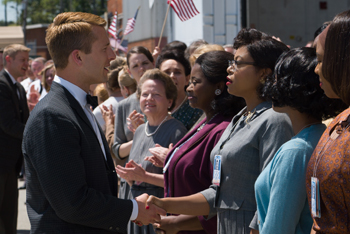 At the Langley Memorial Research Lab in Hampton, Virginia – run by the National Advisory Committee on Aeronautics, or NACA, a precursor to NASA - the search was on for luminous minds from nonconventional backgrounds. They needed gifted people to serve as 'human computers" – that is those rare people with the grey matter to complete rapid-fire, advanced calculations in their minds, before we had digital super computers that could precisely plot out rocket trajectories and re-entry paths.
At the Langley Memorial Research Lab in Hampton, Virginia – run by the National Advisory Committee on Aeronautics, or NACA, a precursor to NASA - the search was on for luminous minds from nonconventional backgrounds. They needed gifted people to serve as 'human computers" – that is those rare people with the grey matter to complete rapid-fire, advanced calculations in their minds, before we had digital super computers that could precisely plot out rocket trajectories and re-entry paths. Recalls Katherine G. Johnson of Sputnik: 'All our engineers were mad somebody else did it first. But what most people didn't know was that we were right behind the Russians and we were ready."
It was in this context, that NACA became NASA and all of its scientists and mathematicians, including the 'human computers," shifted into the space program at high velocity.
Despite the Jim Crow laws still undermining equality and human rights in Virginia, Langley hired an entirely female team of these 'human computers," a number of whom were African American math teachers. They remained segregated, with black women eating in separate quarters and working apart in a remote division known as West Computing. They were paid less than their white counterparts. Yet, their extraordinary work rose above – and ultimately so won over the men in their midst that they became utterly indispensible to the boldest mission yet: putting John Glenn into full orbit around earth.
Even before NASA saw their untapped genius, these were astonishingly special women:
Johnson was a West Virginia phenom who started high school at 10 and had graduated with degrees in Mathematics and French at 18 before becoming one of the first to integrate the graduate school at West Virginia University, starting at Langley in 1953. While she was working for NASA, she was also a single mother raising three children
Vaughan was equally accomplished, a Missourian who graduated from college at 19 and worked as a math teacher before joining Langley in 1943. She quickly became the head of the West Computing group.
Jackson was a local from Hampton, Virginia with degrees in Physical Science and Mathematics. She rose to Aerospace Engineer after joining Langley in 1951, specialising in wind tunnel experiments and aircraft data, always using her position to help others.
As special as they were, the women took their accomplishments in stride. For Johnson, it seemed normal to possess extraordinary math skills, because they came to her organically from a very young age. 'Almost as soon as I was born, I loved to count things," she remembers. 'I was always counting the stairs, and we had a lot of stairs so I got a lot of experience. I saw that counting was a way to understand things better, to see what things were and what they meant."
Even at NASA, Johnson felt driven first and foremost by her curiosity about the world, and never drew attention to herself as a heroine. 'I approached it as: if someone asked me to solve a problem, I did it," she states matter-of-factly. 'But I always wanted to know more about the importance of what we were doing. If we were doing a calculation, I wanted to know: What is this for? Why is it vital?"
As for leading a triple life as a mother raising children, an African American woman navigating Jim Crow laws and as a major asset for NASA, Johnson says she never felt she wasn't up to the task. 'A woman can always outdo a man in managing multiple things at once, so it was no problem," she muses. 'And at NASA, we were all working toward the same goal, whether we knew it or not."
It stunned author and executive producer Margot Lee Shetterly, whose father worked at NASA, that these women remained relatively unknown. Margot Lee Shetterly wrote her novel Hidden Figures based on oral interviews, extensive research and archival information, chronicling how the women of West Computing met the challenges that faced them with grace and optimism, forged alliances that helped them gain respect and aided one another to change their own lives even as they were changing the country and technology forever. She also founded the Human Computer Project, which has received two grants from the Virginia Foundation for the Humanities, an organisation dedicated to archiving the work of all the women who contributed to the early history of NASA.
She was especially moved by how the women themselves downplayed what they faced. Says Margot Lee Shetterly: 'These women were hidden in plain sight in a way. They felt they had a chance to do jobs they loved – and they loved this challenging math - so they didn't draw attention to themselves." But now is the time to draw attention to these women, Margot Lee Shetterly believes. 'In the past, we've been blind-sighted about women in technology," she comments. 'We have this image of what an astronaut or a scientist looks like, and since these women did not fit the profile, historians often looked past them."
Margot Lee Shetterly set out to give the women their full due in her book. One thing Margot Lee Shetterly wanted to get across is how much these women could do with pencils and sheer brainpower. 'There's more computing power in a toaster today than was available in the 1960s," laughs Margot Lee Shetterly, 'yet we were able to send a man into space, then to the moon. That is because raw computing power came from these women."
Especially inspiring to Margot Lee Shetterly was how the women navigated clashing realities – as high-level minds on the one hand and as African Americans confronted with daily institutional bias on the other. 'It must have been something to be so into your work, so fascinated by these big mathematical problems - and then you have to go use the -coloured bathroom,'" she muses. 'Then you come back and still have to hold your head high, despite having your status as a second-class citizen pointed out again and again."
Bonding closely together helped the women find strength, says Margot Lee Shetterly. 'They were a band of sisters. They knew they had to support each other and they encouraged each other to give 150% because they also knew they were going to be scrutinized in a different way. I think they saw they had a rare chance to open doors to other black women in a future that would be different," she concludes.
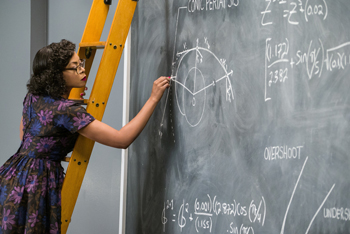 Now, there has been a burst of fascination with NASA's women, especially as efforts to recruit more women into STEM (science, technology, engineering and math) fields take off. 'A number of people did historical work and published articles in the past," notes the film's NASA consultant Bill Barry. 'But it didn't catch on with the public imagination until now. Now there's a growing interest now in how we can really encourage women to follow their passions in science, engineering and math."
Now, there has been a burst of fascination with NASA's women, especially as efforts to recruit more women into STEM (science, technology, engineering and math) fields take off. 'A number of people did historical work and published articles in the past," notes the film's NASA consultant Bill Barry. 'But it didn't catch on with the public imagination until now. Now there's a growing interest now in how we can really encourage women to follow their passions in science, engineering and math." When the manuscript crossed Academy Award®-winning producer Donna Gigliotti's desk, she too was shaken by the women's hidden status and stirred by all they had accomplished at a time when their achievements went unrecognized. 'We develop a lot of material – but this story was so unique," says Donna Gigliotti. 'It's a part of history that needed to be heard, and I knew this was a movie I had to make."
Launching The Project
Donna Gigliotti quickly found that no one she spoke with about the film project had any clue of the existence of a pool of female math whizzes at NASA. 'It's mind boggling that so few people know this story. However, I want to say this: the information was all there," she points out, 'but it has taken several generations for Katherine, Dorothy and Mary to get the public credit they've long been due."
Donna Gigliotti struck out in search of a woman writer to take this obscured story all the way to the screen, and was exhilarated to find one with a remarkably matched background: Allison Schroeder, who not only studied high-level math but interned at NASA, following in the wake of her grandmother, a programmer at NASA from the early days through the shuttle program, and grandfather, who took part in the Mercury project.
Much as Allison Schroeder knew about NASA history, she, too, had never encountered the names of Katherine G. Johnson, Dorothy Vaughan and Mary Jackson. She couldn't believe this inspiring story of women's empowerment in the world of space science had been buried out of her sight, even as an insider.
'I did know about the -human computers' at NASA, but I honestly never had heard there was a separate African-American pool of computers," explains Allison Schroeder. 'By the time my grandmother began working there, it was already more integrated. I did know a lot of women worked at NASA. I remember NASA came to our school in the 8th grade and recruited women and minorities for internships. That's how I got involved in NASA and in math and science. So, I knew NASA was big on including everyone."
NASA's first big shot at inclusion - and how Johnson, Vaughan and Jackson fought with their hearts, minds and souls to make it work - came to the fore of Schroeder's screenplay, which spotlighted the women's friendship and teamwork. Despite the heady topic, the humanity and humour of the story instantly spurred interest.
Donna Gigliotti recalls that early on, Octavia Spencer, who plays Dorothy Vaughan, and Pharrell Williams, who serves as a producer, co-composer and songwriter, came aboard, galvanizing things further.
'Octavia Spencer had gotten hold of the script and said she had to be part of the movie. Meanwhile, Pharrell Williams got in touch to say he would do anything to join the project. He told me, -This happened ten miles from where I grew up. I am obsessed with space and a big proponent of the STEM initiative as well.' So Pharrell Williams and Octavia Spencer came in early and they hung in," says Donna Gigliotti.
Like Donna Gigliotti, Pharrell Williams could not believe the African American women who helped bring triumph to NASA had yet to be celebrated in popular culture. He saw the story as having an inherent power to break down perceptions and move people of all backgrounds.
'The empowerment you get from this story is just remarkable, and it's not fiction," Pharrell Williams says. 'These women changed the world with their incredible minds – and that is a leading example of what empowerment is. Katherine thought to herself: what obstacles? Because in her mind, there was an equation for everything. We needed people like that then and we need them as much now."
Pharrell Williams continues: 'I've been obsessed with NASA since I was a little boy growing up nearby, so this story really had everything for me – it's about science, it's about amazing women, it's about African-American women, it's about the 60s and it's about space. I had to be part of that."
He is especially thankful to Donna Gigliotti for bringing the material to the world. 'This story has been around for 50 years, but no one else saw the light until Donna Giliotti saw it," says Pharrell Williams.
Pharrell Williams is excited for today's audiences to have the chance to meet Katherine G. Johnson. 'She is someone who while surrounded by the darkness of the past, saw the future. She saw a future where woman superseded all expectations and were equally valued – and the sooner we all see that, I think the better our planet will be," he sums up.
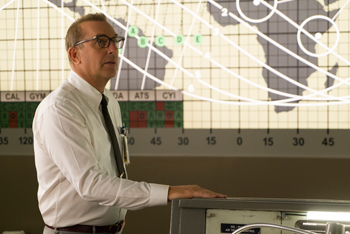 Next, the search was on for a director who could turn slide rulers, equations and mathematical virtuosity into the stuff of dynamic drama. Deeply moved by the script, Theodore Melfi, who drew accolades with the Golden Globe-nominated comic-drama St. Vincent starring Bill Murray, fought to take the helm. He was up at the time for the potentially blockbuster Spiderman, but chose to have his name taken out of the running purely in order to pursue Hidden Figures.
Next, the search was on for a director who could turn slide rulers, equations and mathematical virtuosity into the stuff of dynamic drama. Deeply moved by the script, Theodore Melfi, who drew accolades with the Golden Globe-nominated comic-drama St. Vincent starring Bill Murray, fought to take the helm. He was up at the time for the potentially blockbuster Spiderman, but chose to have his name taken out of the running purely in order to pursue Hidden Figures. Donna Gigliotti recalls: 'Theodore Melfi said, -This film is too important and everyone should know this story.' He had such a high level of passion, he turned away other opportunities. He's a man of real integrity."
Theodore Melfi brought aboard trusted partners in renowned media executive Peter Chernin and Jenno Topping of Chernin Entertainment, the team who had produced St. Vincent (and most recently produced Tim Burton's Miss Peregrine's Home For Peculiar Children.) Topping says they saw the film as exactly the kind of project Chernin Entertainment wants to champion and a compelling fit for Theodore Melfi's talents. 'I think Theodore Melfi is drawn, and we are drawn, to stories of unlikely or unrecognized heroes," says Jenno Topping. 'St. Vincent is a film about everyday heroism, but obviously this story was different. These women are hugely accomplished in their field -- but the larger world hasn't heard this story yet. I think Theodore Melfi is also a filmmaker who has a deep interest in humanism and this is a story that shows both the very best of humans as well as the darker side."
Topping continues: 'Hidden Figures really is a perfect balance of the inspirational, the historical, the humorous and the moving – it runs the full gamut of emotions. And that's what audiences want more than anything: to be entertained and informed but also inspired and uplifted. It's a story that feels like its moment has come. People were drawn to it so strongly that it was an unusually fast process. We wrapped production less than a year after beginning to put the picture together."
Perhaps the most imperative reason behind Theodore Melfi's passion for Hidden Figures is that he is the father of two daughters. 'I try to tell my daughters everyday that you can do anything on the planet you want to do if you put your heart and soul into it – and that includes math and science," Theodore Melfi explains. 'I want them to know you have real value and you can create a satisfying life for yourself with your brains. I felt this was a chance to let girls know they can aspire to be a Katherine Johnson."
Right away, Theodore Melfi knew the approach he wanted to take: 'I wanted the film to explore the part of the story which is not documented at all, which is what it was like for three African-American women to be working in segregated NASA even as all these accomplishments were taking place," he says. 'I love the double meaning of the title because so often women have only been looked at as superficial -figures,' rather than as great figures. But these women were the literal Hidden Figures that changed the space race."
He also hoped to re-create a more optimistic time in America when people aimed at breaking through barriers with a sense of belief. 'At that time, there was a real sense of national pride surrounding the space race and President Kennedy appealed to everyone to push the envelope. He spoke to the innate urge in all of us to find out if there's something more, something better," says Theodore Melfi.
Jenno Topping was especially excited to see Theodore Melfi working with such a big, diverse cast of veterans and newcomers who bring the characters to life in their vivid nuances. 'Theodore Melfi really loves actors, he understands actors, and I think this cast was such a fun playground for him to work in, and he really went all the way with them," she says.
Throughout, Theodore Melfi consulted closely with NASA and NASA historians. Although he was not setting out in any sense to create a documentary, he did want the film's fictionalized drama to reflect the spirit of the early space pioneers from all walks of life. 'NASA was fantastic and indispensable, especially with the getting the science right. They were incredibly supportive of the project," he says.
Most of all, Theodore Melfi felt the story would resonate with audiences looking for an inspiring vision of a future that includes everyone in America pulling to reach our biggest goals. Says Theodore Melfi: 'In this story, you see how skill and knowledge are equalisers. During the space race, when we put everything aside and said, -whatever race or sex you are, whatever background you have, if you can do the math, please help us get to the moon' something amazing happened. People were valued for their talents and in turn gave their country valuable and precious gifts."
He concludes: 'A country divided along any lines can accomplish little, but a country united and inspired to work together can achieve the very best."
That became a foundational theme as Theodore Melfi steered the production – as did the idea of sisterhood. 'These women were so individually talented, but they rose together, standing with each other, and that's what's so beautiful," concludes Theodore Melfi. 'They empowered one another and everyone won because of that."
Taraji P. Henson On Playing An Unknown Legend
Just as quickly as the script for Hidden Figures began making the Hollywood rounds it also began resonating with leading actresses, including several Donna Gigliotti had originally envisioned taking key roles. Ultimately a trio came together who were each committed to immersing themselves into the utterly different lives and times of the film's mathematicians turned space pioneers.
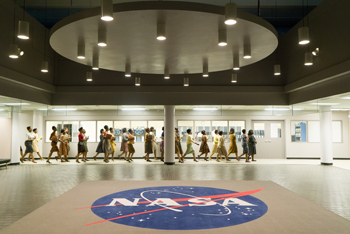 Leading the threesome is Taraji P. Henson, who has been rapidly rising in roles that include her Oscar®-nominated turn as adoptive mother Queenie in David Fincher's The Curious Case of Benjamin Button and equally her Golden Globe, Emmy-nominated and buzz-generating role as the powerhouse hip-hip mogul's wife, Cookie Lyon, on television's mega-hit Empire.
Leading the threesome is Taraji P. Henson, who has been rapidly rising in roles that include her Oscar®-nominated turn as adoptive mother Queenie in David Fincher's The Curious Case of Benjamin Button and equally her Golden Globe, Emmy-nominated and buzz-generating role as the powerhouse hip-hip mogul's wife, Cookie Lyon, on television's mega-hit Empire. Taraji P. Henson is joined by Octavia Spencer, who garnered an Oscar®, Golden Globe, BAFTA and countless other honours for her pivotal role as outspoken maid Minny Jackson in The Help and has since been seen in wide-ranging roles from the hard-hitting drama Fruitvale and the sci-fi thriller Snowpiercer to the animated Zootopia. Completing the group is an exciting newcomer: Janelle Monáe, best known for her career as a six-time Grammy-nominated pop star, debuting this year in both Barry Jenkins' Moonlight and Hidden Figures.
Taraji P. Henson takes great pride in bringing to the fore for the first time the life of Katherine G. Johnson – the number-genius who helped calculate key trajectories for John Glenn's orbit around the earth and the 1969 Apollo flight to the Moon - and received the Presidential Medal of Freedom in 2015. The role struck her as both an unexpected next move and also, in an exciting way, as a bit unnerving. Indeed, finding her way into Johnson's mix of ease with astronomical numbers and organic defiance of societal barriers has been the biggest challenge of her career to date.
She relished just that. 'I'm a girl who grew up in the -hood," she notes, 'so all I ever had was dreams. And when you come from a place where many people feel they have no hope and all you see is that people who look just like you seem to have no place in society, that can be overwhelming. Maybe if I had known women like this existed when I was growing up, I would have wanted to become a rocket scientist. Not to say I don't love what I'm doing – but there's so much important work to be done in the world and I was so excited to be part of a project that might give kids growing up in places like where I grew up a different vision of what they can be."
Taraji P. Henson goes on: 'So I felt honoured just to have this chance to portray a woman like Katherine. There was a flood of emotions surrounding that – and there was also fear because I am not that mathematically wired. But I think that so scared me, I felt I had to do it. I couldn't say no."
Most of all, she felt stirred by Johnson's refusal to let her circumstances knock her off course. 'It was as if Katherine had every obstacle stacked against her, and yet nothing at all could stop her. That was one of her gifts and that is her legacy," notes Taraji Henson.
It does strike Taraji Henson that ex-con Cookie Lyons and space hero Katherine G. Johnson could not be any more different, other than both being complex women – but she was excited to explore such a different side of the American experience. 'I was so honoured that the filmmakers thought of me to take this role. They saw past Cookie and saw that I am interested in doing other things and I'm grateful for that," she says. 'Once I took the role, I really quickly shed Cookie and jumped into Katherine's world."
Donna Gigliotti observes: 'Cookie and Katherine are apples and oranges. But Taraji Henson is so smart, so funny and so compelling to watch – that's why she was able to step into this completely different role."
Adds Jenno Topping: 'It never felt like a risk to cast Taraji Henson because she always felt like Katherine to us. Ted wanted her from the beginning – and you can see that she is an actor at the top of her game right now. Also, her passion for the project was just infectious."
Still, Johnson's aura preceded her. Says NASA consultant Bill Barry of Johnson's numerical wizardry: 'Katherine had a facility with mathematics that boggles the mind. It quickly became apparent after she was hired in 1953 that she had very unusual talents. So when the Space Task Group formed, she was pulled in because they required the very best of the best. And she was a force to be reckoned with."
Although NASA had just begun using cutting-edge IBM computers, John Glenn specifically requested Johnson to recheck the calculations by hand before his orbital flight aboard Friendship. She was that good. John Glenn refused to even think about risking a trip into space until her figures came back.
Taraji Henson hoped to express not only Johnson's beautiful mind but her ceaseless energy and positivity. 'It was the early 60s and there was racism and sexism everywhere, no doubt. Yet here is this woman who didn't let any of that hold her back," say Henson. 'We don't have enough images for girls of women like this, black or white. We just don't and I think it's so important."
Johnson is at last being recognized. On May 5, 2016, the Katherine G. Johnson Computational Research Facility was dedicated at Langley Research Center. The date was the 55th anniversary of Alan Shepard's historic rocket launch and splash down, which Johnson helped make possible.
Taraji Henson, who met with the nonagenarian heroine to talk about her experiences, believes a big part of Johnson's drive was not so much having her own chance to shine but the even more rare chance to raise others up. 'When I met Katherine she told me that one of her professors once said, -I am sick and tired of you asking questions when I know you know the answers.' Katherine's response was, -Well, I know these six students around me don't know the answer and I want them to understand it the way that I do.' That is an incredible person who thinks that way," Henson comments.
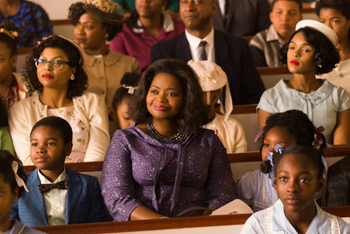 Theodore Melfi saw a reflection of Johnson's determination in Taraji Henson. 'Taraji Henson has that same ability as Katherine to tackle something in a fast, precise way, which she did with this role," he says. 'She was in her hotel room learning math and she would come to the set and just be ready to do it. She did a tremendous job of creating a very contained performance and really put herself in Katherine's shoes."
Theodore Melfi saw a reflection of Johnson's determination in Taraji Henson. 'Taraji Henson has that same ability as Katherine to tackle something in a fast, precise way, which she did with this role," he says. 'She was in her hotel room learning math and she would come to the set and just be ready to do it. She did a tremendous job of creating a very contained performance and really put herself in Katherine's shoes." Adds Pharrell Williams: 'Taraji Henson is a wizard of emotions. She's able to take herself in just two seconds flat somewhere very deep."
For Johnson, Taraji Henson notes, there was no question of whether she was up to the high-stakes work of NASA. 'When you talk to Katherine about the bias of the times, she takes the tone of -that's just how it was.' For her, you got on with it, you did your job, and you did what would hopefully bring change. And that was the huge opportunity she got at the Space Task Group. They didn't care who she was if she could get them the numbers they needed. She was part of a larger human goal and that meant a lot."
Perhaps the most moving element for Henson is the camaraderie of the women at West Computing – their desire to bring each other along for this amazing ride. 'What struck me talking to Katherine is that she never takes sole credit," concludes Taraji Henson. 'She only uses the words -we' and -us.' That's when you know someone has a true gift to give the world – when it's not about you but about your ability to use what you have to reach others. She understood her purpose. To this day she is very clear."
Octavia Spencer On Playing a Matriarch Of NASA Women
Like Taraji P. Henson, Octavia Spencer felt a magnetic attraction to playing Dorothy Vaughan, in part because she couldn't believe her astonishing story isn't more widely known. 'I was drawn to the fact that we haven't known about the contributions these brilliant NASA women made to our advancement and to the space race. That so intrigued to me," says Octavia Spencer. 'Whenever I choose a role, it has to be something that I'm intrigued by or enlightens me in some way. This movie had both of those combined."
She goes on: 'This movie is set in such an interesting time for our country, when it was redefining itself into what we are now. And the beautiful thing of looking back at history, as this film does, is contemplating how we can influence the future. I'm really hopeful that after seeing this story, there will be girls in the world will realize just how much value they have."
One of Octavia Spencer's favourite lines that she delivers as Dorothy Vaughan is: 'No one can tell you that you're better than anyone else, and nobody can tell you that you're less than anyone else."
'I definitely came from humble beginnings," notes Octavia Spencer, 'and one thing my mother drummed into us is that your station in life doesn't dictate your path in life. So to have Dorothy Vaughan say something so similar to what I've always been taught … well, I knew that I was definitely playing the right woman."
Dorothy Vaughan, who passed away in 2008, continued to work with NASA for most of her life. As soon as newfangled IBM computers arrived on the scene, it was Vaughan who sensed a brave new era in the making and quickly changed gears, specializing in electronic computing and FORTRAN programming, making herself and her co-workers indispensible. Among the women of West Computing, she was seen as a leader and Katherine G. Johnson called her the smartest woman she ever met.
'Dorothy Vaughan was by all accounts a saintly woman. People loved her," says Donna Gigliotti. 'To this day, Katherine talks about Dorothy in a way that tells you how important she was to her."
Adds Theodore Melfi: 'Dorothy was the matriarch of this group of women – she helped a lot of them get their positions and she really took care of them. She never could become an official supervisor because of the politics of the time, but she played that role anyway."
Jenno Topping notes that Spencer seemed to embrace all of that organically. 'She opened herself so fully to this project," says Jenno Topping.
Octavia Spencer felt the weight of trying to bring the woman who earned that kind of respect to life with a resonant truth. She tried to give herself over to the spirit of Dorothy's persona. 'This is my second time playing a person who really existed, and I did feel it was important to really capture her personal integrity.
I wanted Dorothy Vaughan to be remembered by her own actions, so I approached it thinking I'm just the vessel through which the world will be able to see all that Dorothy contributed," Spencer explains. She continues: 'Dorothy Vaughan was also very selfless and I think because of that extreme selflessness it was hard for her to gain her place as quickly as Katherine and Mary did. At the same time, she really believed in women and she made sure that every step forward for her was a step forward for all of them."
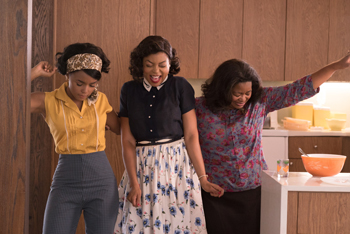 For Octavia Spencer, the fullness of the role – allowing Dorothy Vaughan to be both staggeringly talented and humanly complicated – was itself a rare joy. 'It's so wonderful to get to play a strong woman, but I'm appreciative that each of these women are also allowed to have their vulnerabilities," she comments.
For Octavia Spencer, the fullness of the role – allowing Dorothy Vaughan to be both staggeringly talented and humanly complicated – was itself a rare joy. 'It's so wonderful to get to play a strong woman, but I'm appreciative that each of these women are also allowed to have their vulnerabilities," she comments. Like Taraji Henson, Octavia Spencer loved finding communion with her cast mates. 'This is a movie about sisterhood," she says. 'Teamwork was so important at NASA and for these women, anything that any one person did affected the entire community. So we had to embody that together."
Octavia Spencer credits Theodore Melfi with keeping the cast bolstered and connected with his overriding vision of the film. 'Theodore Melfi came to the set having explored this story inside and out, and his exuberance was felt in every element," she summarises. 'He's truly one of the most collaborative people I've known. And it was really moving to know that this film has an extra importance to him because he has daughters and he understands why it's so essential that we tell stories that give young girls a sense of their worth."
Janelle Monáe On A Taking a Major Screen Role
Best known for her futuristic pop star persona, Janelle Monáe was an out-of-the-box choice to play Mary Jackson, but the filmmakers thought it was a chance worth taking. 'We were all aware that it was going to be a leap for her to take this on as a first major role [Janelle Monáe also appears this year in Moonlight], but Janelle Monae has such a fantastic personality. And when we tested her, we saw she has tremendous charisma on screen, a dynamism that you can't deny," says Donna Gigliotti.
'She has so much fire," says Theodore Melfi. 'She's vibrant as Mary. You can see her saying something in every moment just with her body language"and that is so fun to watch. To me, she has the feel of a glamorous 40s movie star."
Like her cast mates, Janelle Monáe was fuelled by the hope of doing the women of West Computing justice. 'To be part of telling this history was so motivating to me," she says. 'These women literally changed the world by allowing the first astronaut to orbit earth. From the time I received the script and was asked to audition, there was nothing more important to me than taking on the role of Mary Jackson."
Once she got the part, Janelle Monáe dove into her preparation with gusto. 'I did a lot of research on Mary. She's passed on, but her spirit still lives," she says. 'Even though I never had the chance to speak to her she has definitely spoken to my heart. I saw her as someone who wants fairness. She knows she is smart and she is not going to belittle herself or dim her light to make anybody feel comfortable."
For Theodore Melfi, the casting of Taraji Henson, Octavia Spencer and Janelle Monáe opened up all the doors he needed to allow audiences to get to know these women nearly lost to history on a personal level. 'Taraji Henson seems so against type, but she's so fresh in this role; Octavia Spencer shows not only genius in her craft, but also in her humour; and as a newcomer, Janelle was just impressive," he sums up.
The ensemble nature of the performances brought an additional layer for each of the leads to excavate. 'I love the relationships between these women," comments Taraji Henson, 'with Mary and Dorothy always bickering and Katherine being the quiet observer in the background. I love that they accept each other for who they are. It's rare that you see a movie where you have three female friends, particularly African Americans, who love and support each other like you see here."
Kevin Costner on Wrangling The Space Task Group
It is the Space Task Group Leader - the perpetually energetic, gum-chewing, glasses-cleaning Al Harrison - who tells his NASA engineers in the heat of the moment: 'We all get there together – or we don't get there at all." Taking the role of Harrison, a fictional character based on a composite of several real leaders at NASA, is Academy Award®-winning actor and filmmaker Kevin Costner. 'Kevin Costner plays a key figure at NASA who's based on several people, including the administrator of NASA at the time, James Webb," explains director Theodore Melfi. 'These were guys who were highly motivated to get Americans into space – and they were interested more in numbers and science than anything else. For them, anyone who could do the work that would get a man into and out of orbit safely was welcome."
Theodore Melfi continues: 'We were very excited to have Kevin Costner join us because he brings such generosity with his talent and his spirit. He already has that kind of infectious personality that creates a team instantly, which matched the character. He really comes to work to be of service – to his fellow cast members, to the character he's creating, and to the story. To me, he can do no wrong."
Kevin Costner gravitated to the script instantaneously. As with others, the story knocked him for a loop.
'What is amazing is that we know the United States was built by the skill of extraordinary people, but the people who gave so much haven't always received the public attention they're due," he observes. 'These women might not have their names everywhere but they were of major consequence to the space program, to real people's lives and really to all of us."
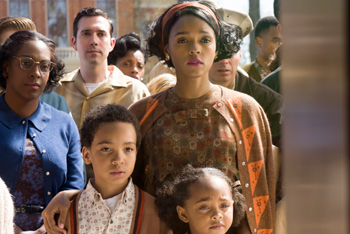 He was intrigued to enter a world few outsiders ever really get to see – the back rooms where the real work of NASA took place before any spectacular takeoffs or journeys to the stars could follow.
He was intrigued to enter a world few outsiders ever really get to see – the back rooms where the real work of NASA took place before any spectacular takeoffs or journeys to the stars could follow. 'Scientists and engineers are a different breed," Kevin Costner notes. 'So the key for this role was really understanding what Al Harrison was up against: trying to get the best and brightest minds at NASA all working together on an idea that no one knew for sure would work. There was only the idea that we had to get into space but he had to figure out how to get all these different people to focus on that one goal."
Kevin Costner realised it could not have been easy. 'The reality is, when you put a lot of talented scientists in one room, they can be very individualistic and aren't necessarily going to all get along. A lot of scientists are so immersed in what they're doing, they can be myopic, and not see other people. So someone like Harrison not only has to come up with ways to tackle and solve mathematical problems, he also has to deal with the human elements of jealousy and fatigue and bias," he explains.
One motivation was beating the USSR, which at the height of nuclear brinksmanship, was hugely significant. 'A lot of it came down to good, old-fashioned competition," notes Kevin Costner.
As for why Al Harrison takes a chance on Katherine despite the Jim Crow laws and other barriers, Kevin Costner says it would have been a no-brainer. 'Al is so goal oriented, he does what needs to be done," he says. 'He needs a mathematician who can think differently than anyone in the room. So is he surprised that it is an African-American woman who turns out to be the one? Yeah, he has that moment. But it really comes down to one question: Can you do this? He's almost like a sports coach. He just needs to know that Katherine can play at a high level and he gets the answer he wants."
Harrison is also the one who decides to tear down the sign that keeps the bathroom off-limits to African-Americans. 'I think he's saying: a new culture is going to be starting here," says Kevin Costner. 'It's not a heroic act. These women were the real heroes, but he is just saying enough is enough. That's not a sign the women could tear down, but he has that power, so he uses it."
Kevin Costner relished the chance to work with Taraji P. Henson so closely. Taraji Henson is a really good actress and she was really good for this movie," he says. 'Theodore Melfi put a lot of faith in her and I can see why. There was a lot of trust between us right from the start and she gave a lot."
Says Taraji Henson of Kevin Costner: 'He blew my mind with all the subtle things he brought to his character. I had to remind myself to stay in the scene sometimes because I was so in awe of his work."
Jim Parson and Kirsten Dunst on Paul Stafford and Vivian Mitchell
Kevin Costner's Al Harrison relies on his lead engineer, Paul Stafford, to bring the work of the Space Task Group to fruition, but Stafford is facing his own internal struggle. Taking the key role is Jim Parsons, renown for his multiple Emmy Award-winning and Golden Globe-winning role as Sheldon Cooper in the long-running television hit The Big Bang Theory. Parsons also has received accolades for starring both on stage and on cable television in The Normal Heart, Larry Kramer's lauded history of the HIV/AIDS crisis in early 1980s New York.
Director Theodore Melfi found that Jim Parsons had a bead on the role from the day they started talking about it. 'Jim Parsons said, -I want to be a guy who is scared to lose his job, who is a bit afraid of a woman appearing smarter than him or to be surpassing him.' He based his whole performance on that fear - and to me it was a genius characterisation of a guy who is blinded by being desperately afraid for his own success. Once he took on the part, Jim just vanished into it. He disappeared and became this guy petrified of a woman at his desk."
Jim Parsons had a strong reaction to the script. 'It's an important piece and I don't use that term lightly," he says. 'It reminded me of doing The Normal Heart, because it's also based on real-life events and takes place during a very important time for our country. It's about a triangle of things that are still very much with us: the idea of exploring space as a uniting human event, the playing out of the Civil Rights struggle and the issue of equality between the genders."
As for Stafford, Jim Parsons describes him as 'someone who is very proud to be part of this patriotic mission." Jim Parsons continues: 'He wants to do what needs to be done to get America back on top of the space race, but when he sees Katherine solving problems, he's not thrilled she outshines him. That hurts his pride. But he up breaking through and he changes. I think he's a great example of how you might not connect with somebody different from you until a common goal is suddenly shared. When you start accomplishing things together, suddenly you see all these commonalities. He's forced to take Katherine seriously by necessity, but once he does, he sees all the gifts that she brings."
Also joining the cast of Hidden Figures is two-time Golden Globe nominee Kirsten Dunst (Spiderman series, Midnight Special) in the role of NASA supervisor Vivian Mitchell, who oversees the 'human computers" with an iron hand. Says Theodore Melfi: 'Kirsten Dunst has a very challenging role in this because she represents some of the unconscious bias and prejudice of the times. Kirsten Dunst approached it in a very complex and subtle way, playing Vivian Mitchell as someone who doesn't want any other woman to get ahead because she feels threatened by that, and is largely unaware of her discriminatory behaviour."
Like her fellow actors, Kirsten Dunst was shocked to hear for the first time about the women of NASA. 'I had no idea there were human computers before there were electronic computers – and I had no idea there were women, black or white, doing this work, so I really wanted to be part of telling this story."
Kirsten Dunst notes that Vivian is herself in an unusual position as a women given supervisory power – which she feels can be taken away at any moment, a pressure that hangs over everything she does. 'She's a female supervisor getting pressure from men to deliver and then she has to deal with the reality of a segregated system at that time and I think that pressure really builds in Vivian. It makes her very aggressive because she feels she could lose her position at any time," Kirsten Dunst observes.
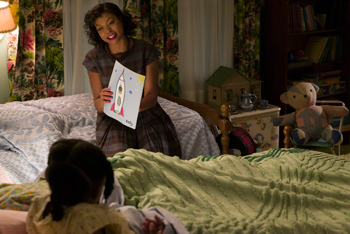 She goes on: 'She's also a lonely person and I don't think she necessarily wants to be a bully but that's the position she feels she has been put in."
She goes on: 'She's also a lonely person and I don't think she necessarily wants to be a bully but that's the position she feels she has been put in." Vivian is also a product of the Jim Crow South and follows the protocols of segregation as if it was ordinary – because it was at that time. To Kirsten Dunst, the most important thing was to give the character her due, despite the fact that at times she acts as a barrier to the film's heroines. 'Vivian's the type of role that could be very cliché, to be honest. You could play her in a very one note kind of way, but I wanted to look inside her to make her more human," she concludes.
Math Boot Camp
Mathematicians and movies have long been strange bedfellows. Math is complicated, internal and not easily expressed visually. At the same time, those amazing humans who can see deeply into mathematical worlds off-limits to the rest of us can be utterly fascinating. Hidden Figures focuses on the lives of NASA's African-American women as they struggle to solve brain-twisting problems while also breaking down barriers – but it was also essential to get the numbers that meant so much to them right. After all, just one degree off in their equations could have meant unthinkable tragedy for NASA.
To oversee the film's mathematical equations and to prepare the cast for how mathematicians think, the filmmakers brought in consultant Rudy L. Horne, Ph.D., an Associate Professor of Mathematics at the historically black Morehouse College. Horne teaches a variety of courses at Morehouse College but his specialty is applied math, the branch that looks to solve problems in the real world.
Horne was taken by surprise at the invitation to join the production. 'I never could have imagined consulting for a movie," he laughs, noting that it's not a common position for mathematicians. 'But it's been a lot of fun, and I even learned some new math out of it."
Taraji Henson spent a lot of time studying with Horne and trying to wrap her mind around challenging numerical concepts and even solve equations. Though Taraji Henson once thought she wanted to be an engineer, she never had done anything like this before – and she had to confront and get past that fear of math. 'It was difficult," she confesses. 'But I also felt there are people who will watch this film who have made math their life and I better get it right. It was so hard, I wanted to cry some nights. But I had to do it because I am one of those people in the audience who would be unhappy if the math is wrong!"
The anxiety Taraji Henson felt about Horne's homework ultimately turned into the joy of mastery – something Henson thinks too many people never experience with math. 'At first it brought back all these traumatic memories of getting a big fat F in pre-calculus," she laughs. 'And when I first started doing these equations my heart would palpitate and I would sweat and worry I would be a failure. So I had to leap some personal hurdles for this role. But what happened is that I proved to myself I could start to at least memorize these numbers and equations very well, and understand some of it."
Producer Pharrell Williams hopes the film's energetic take on math's beauty, importance and ability to create exciting things will encourage more women and minorities to take the leap into a field they may not have considered. To him, it is just as awesome as becoming a singer, actor or filmmaker.
'The idea of STEM is very important to this film," says Pharrell Williams. 'I consider math to be a real art and it's also a universal language. It doesn't even matter what solar system you're in, math applies."
A Hidden Side Of NASA: The Design
Hidden Figures takes audiences into a world they have never seen before – the remote, segregated arm of NASA known as West Computing, which co-existed with the Jim Crow South of Virginia in the early 1960s. To bring this hidden side of NASA and American history to life, director Theodore Melfi recruited a crack team of craftspersons led by director of photography Mandy Walker, production designer Wynn Thomas, editor Peter Teschner and costume designer Renée Kalfus.
'The look of the film captures something unexpected about the incredible beauty of these women and their house and their lives," observes Jenno Topping. 'It was all approached with enormous care, and Wynn Thomas, Renée Kalfus and Mandy Walker are just masters at their crafts."
Theodore Melfi was especially excited to have the film shot by one of Hollywood's still relatively rare female cinematographers. 'I don't understand why there are so few female DPs," the director comments. 'Mandy has such a brilliant aesthetic and eye for what is beautiful. She doesn't need smoke and mirrors – she finds a natural, raw frame lit in the most stunningly, organic way."
From the start, Mandy Walker and Theodore Melfi talked about iconic photographers of the period, particularly Saul Leiter, a pioneer of the so-called New York School of photography, which emphasised lush, colourful, humanistic street scenes. They also talked about a theme Theodore Melfi had in mind.
'For me, the word of this movie was -through.' Everyone's going through something. The women are going through obstacles of racism and sexism. The U.S. is going through space," Theodore Melfi elaborates. 'So we talked about using the camera to shoot through doorways, windows, through any and all objects. We set out to find beauty and emotion through things. We didn't overdo it, but whenever we could, we approached things that way."
Theodore Melfi and Mandy Walker also made the decision to shoot on celluloid film rather than digitally to befit the handcrafted era when the space program was still doing calculations on paper. It also gave Mandy Walker warm contrasts to work with. 'I was really glad when Ted told me that he wanted to shoot on film," says Mandy Walker. 'We felt that it would handle the contrast of colour and of light so beautifully."
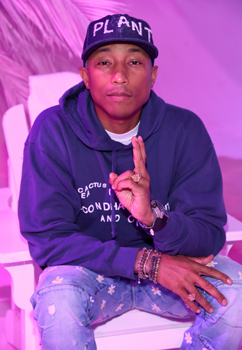 To add to the visual appeal of the period, Mandy Walker also utilised an array of vintage lenses. 'We used older Series Panavision Anamorphic lenses and we also shot on old Kodak stock," she explains.
To add to the visual appeal of the period, Mandy Walker also utilised an array of vintage lenses. 'We used older Series Panavision Anamorphic lenses and we also shot on old Kodak stock," she explains. Mandy Walker worked closely in synch with production designer Wynn Thomas. Says Wynn Thomas: 'There was an incredible exchange of ideas on the look of the movie. We spent a lot of time looking at inspirational photographs and talking about composition. And when you're shooting on film, you need a lot more light, so we need to really work closely to provide the light to support Mandy Walker's wonderful photography."
Wynn Thomas, who also did the design for the mathematically-themed A Beautiful Mind, began his own work with intensive research. 'I looked at endless photographs of NASA facilities from that era, as well as a variety of research material from people's homes," he says. 'Part of what we wanted to do was not only define the times but also help define the characters by showing you their environments."
He acknowledges that the look of NASA's East and West Computing took liberties to create the film's compelling visuals. 'We were not really trying to recreate NASA in precise details. We're trying to create the spirit of NASA at that time, which is a different thing," Wynn Thomas explains.
Wynn Thomas and Mandy Walker especially focused on creating the heady atmosphere of the Space Task Group, where Katherine Johnson is at last invited to enter the exclusive domain of the VIP aeronautic engineers. 'By coming to the Space Task Group, Katherine's whole life changes, so we wanted to design the space to be a feel a bit larger than life, so that Katherine looks a little small and overwhelmed coming into this high-tech world that had previously seemed out of her reach."
Shooting in Atlanta, Thomas had the pleasure of using Morehouse College as the exterior of NASA's facilities. NASA had been designed to function like a college campus, so the filmmakers got a kick out of using one of the nation's oldest black universities to stand in its stead. Buildings featured in the film including the rounded Frederick Douglas Hall. 'That circular building dominates the campus, so we decided to use it as the exterior of Space Task Group. The real Space Task Group was not in a circular environment, but it makes the space so visually interesting," notes Wynn Thomas.
Theodore Melfi was gratified by Wynn Thomas' contributions. 'Everything Wynn touched was magic," he says. 'You can really sense how much he cares in the level of detail he brings. Wynn Thomas really helped us play up the contrasts between the East and West Computing Groups. While East Computing is pristine, warm and bright West Computing is in a dingy basement and all hodge-podge equipment. The way Wynn created it though, it feels unconscious – just the way things were done then, without thinking about it."
Meanwhile costume designer Renée Kalfus was immersing herself in Southern fashions of the early 60s and translating that to the characters' personas. 'It's an amazing experience to work on a film like this, where you have three incredible characters and a chance to really create each one's style," says Renee Kalfus. 'We used a real mix of things, hand making some outfit and also seeking out vintage pieces. I started just by looking at tons of clothing catalogues from that time. We got our hands on several Sears and Wards catalogues, as well as others from the period – and that was a great education."
For Katherine, it was essential to Renee Kalfus that her clothes appear handmade, which they always were. 'That's part of Katherine's story, part of who she is, so it was very important for us to develop homemade clothing as part of her character," Renee Kalfus notes.
Renee Kalfus asked all three lead actresses to wear corsets to really embody an age of girdles and cultivated posture – and to reflect how the women of West Computing aimed to be impeccable. 'A corset does do something to your posture," says Renee Kalfus. 'It gives a certain formality to how you hold yourself and even slows down your movement. We felt it really put Taraji Henson, Octavia Spencer and Janelle Monae into that time."
Theodore Melfi gave Renee Kalfus free reign. 'With Renée Kalfus, I completely trusted her process," comments Theodore Melfi. 'Every piece worn has a reason and an intention. She starts by asking -Why would this character wear this? What does it say about this person?' And then you see the answers in her work."
All these details gave the cast a rich environment in which to explore. Says Kevin Costner: 'When you come onto a set and feel this kind of realism it informs you as an actor. It helps you move, and you start to feel engrossed in the history."
The filmmakers hope that feeling also washes over audiences. 'All movies require an enormous amount of commitment and passion," notes Jenno Topping, 'but I think that was even more true for Hidden Figures because we all felt such a responsibility to honour the real figures the movie is about. That brought an added level of meaning to us: the hope that audiences will get to know and enjoy these wonderful women."
A Soaring Soundtrack
Theodore Melfi was thrilled that ten-time Grammy Award winner Pharrell Williams not only was aboard as producer, but also became another creative force on the film, collaborating with 9-time Oscar® -nominated legend Hans Zimmer on the score and contributing several original songs to the soundtrack.
'As we started talking about the music, I was just so blown away by Pharrell and his passion for this subject matter," says Theodore Melfi. 'Pharrell Williams is a big uplifter of both science and women, so he was a natural fit with this story. And his music is stunning."
Pharrell Williams has always been deeply into the vibe of 60s music. 'As soon as I met with him, he said, -I have ideas,'" recalls Theodore Melfi. 'He kept sending us demos and every time it was like, -holy crap, this is astounding.' I really feel his music gives the film its heartbeat."
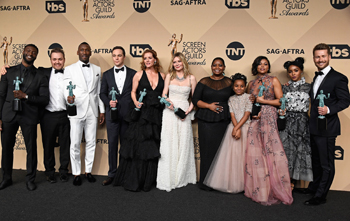 Williams says he could not have been more inspired. 'This story has so much ascension in it, so I felt we had to match it musically. I hope the songs reflect the source of their energy."
Williams says he could not have been more inspired. 'This story has so much ascension in it, so I felt we had to match it musically. I hope the songs reflect the source of their energy." The original song 'Runnin'" – performed by Pharrell Williams - was written from inside Katherine G.
Johnson's head as she's in search of a segregated bathroom she can use, even while working in the upper echelons of NASA. 'I'm a man of course, but I was trying very hard to put myself in Katherine's lyrical shoes in that song," says Pharrell Williams. 'And I've got to tell you, that's tough. I had to really try to imagine what her struggle must have felt like and express it in 3 minutes and 30 seconds. I'm excited that I could even have the opportunity to musically and melodically illustrate what she was going through."
Another original song, 'I See A Victory," is written by Pharrell Williams and Kirk Franklin and performed with eminent Gospel singer Kim Burrell, known for the power of her voice and her signature blending of soulful jazz and R&B with traditional, inspirational Gospel sounds. The full soundtrack also features the voices of Mary J. Blige, Alicia Keys, Lalah Hathaway and cast member Janelle Monáe.
That unusual opportunity to reflect the story of Katherine G. Johnson, Dorothy Vaughan and Mary Jackson in music was a thrill for Williams – just as it fuelled everyone in the production. Concludes Theodore Melfi: 'What united us was telling this story of how a group of people at NASA – black, white, men and women – came together to achieve something great by putting all differences aside. Was it hard? Yes. Was it uncomfortable? Yes. Did it take time? Yes. But great things happen when people unite on equal terms."
RUNNIN'
(Music and Lyrics by Pharrell Williams)
Summertime in Virginia was an oven (oven)
All the kids eating ice cream with their cousins (cousins)
I was studying while you was playing the dozens (dozens)
Don't act like you was there when you wasn't
Runnin' from a man (man)
Runnin' from a badge (badge)
Don't act like you was there when you wasn't
Runnin' towards our plans (plans)
And the judges hands (hands)
Don't act like you was there when you wasn't
I know they say to crawl -fore you walk
But in my mind I already jog
If I stand still, like 'can I get far?"
They want the moon I'm on Mars
Sometimes my mind dives deep when I'm runnin'
I don't want no free ride, I'm just sick and tired of runnin'
Some nights I cry cause I can see the day comin'
Together we'll fly, oh, but no more runnin'
You and I are no different from each other (other)
Shut our eyes when I slumber I see numbers (numbers)
Black and white were computers I am coloured (coloured)
Don't act like you was there when you wasn't
From running to exams (exams)
To jobs for a man (man)
Don't act like you was there when you wasn't
And the law of the land (land)
Where women were often banned (banned)
Don't act like you was there when you wasn't
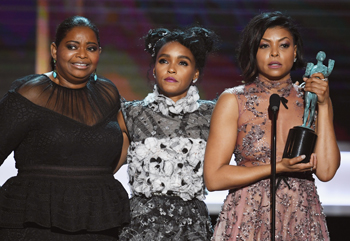 I SEE A VICTORY
I SEE A VICTORY (Music and Lyrics by Pharrell Williams and Kirk Franklin)
They'll call it a mystery, but we're gonna call it
VICTORY!
We'll be right in history it's gon' be
VICTORY!
They'll be signs on top of signs, just so you know the
HISTORY!
It's saying victory, oh oh
IS WITH ME!
Oh let them laugh about it
Don't worry what the doubters saying
Yes it's an uphill battle
But guess who else is playing?
The next time y'all in action
And the ghost is in the room
Watch it work through the masses
You know that we've been used
Let it go, let it be (let go, let it be)
No matter how deep (no matter how deep)
I swear just beneath (I swear just beneath)
You'll find your VICTORY (find your victory)
So I tallied all my losses
And I turned them into lessons
And what seemed to be less
I turned them into blessings
See I'm not trying to lose you
But the spirit is relentless
And when you let go and let it use you
Then you too will be a witness
Bible says you should pray for nothing,
Cause every week it's gon' be something
You know the devil can't wait to jump in
And complicate things you trust in
But I know my foundation is solid
It can take some hatin'
Prayers go beyond the space station
All the way to the Master's apron
About The Real-Life Characters
Katherine Johnson (Played By Taraji P. Henson):
One of the brightest minds of her generation, mathematician, physicist and space scientist, Katherine Johnson was born in West Virginia in 1918. Displaying an early aptitude for math, she was brilliant with figures. Encouraged by her parents and teachers, Johnson attended West Virginia State College and graduated with highest honours.
She became the first African American woman to attend graduate school at West Virginia University, when the state first integrated its graduate schools in 1930. Originally a teacher, Johnson was hired as a computer at NASA's Langley Research Center in 1953. She was assigned to the Flight Research Division and became indispensable, doing calculations for orbital trajectories on the early Mercury flights. Johnson did trajectory analysis for Alan Shepard, the first American in Space. Her math was instrumental to the success of the historic Friendship 7 Mission, in which astronaut John Glenn became the first American to orbit the earth. The early electronic IBM computer was essential to Glenn's flight, but not reliable, so Glenn insisted that 'the girl" (he meant Johnson) manually check the numbers before his flight. The successful flight, of course, marked a turning point in the Space Race between the United States and the former Soviet Union. The stellar mathematician also worked on the calculations for the 1969 Apollo 11 flight to the moon, the Space Shuttle and the Earth Resources Satellite.
Johnson has three daughters from her first marriage to James Goble, who died in 1956. Since 1959, she has been married to Colonel James Johnson. In 2015, Katherine Johnson was awarded the Presidential Medal of Freedom from President Obama.
Dorothy Vaughan (Played by Octavia Spencer):
Born in Kansas City, Missouri, in 1910, Dorothy Vaughan was a gifted child who excelled academically and musically. Her family relocated to West Virginia when she was eight. Aged 15, Vaughan won a full scholarship to Wilberforce University in Ohio. Married to Howard Vaughan, the mother of six was a schoolteacher before joining NASA's Langley Research Center as a computer in the 40s. She was promoted to a management position and became NASA's first black supervisor.
A fierce champion for her staff, Vaughan devoted herself to fighting for promotions and pay raises for both black and white women computers. With the introduction of the first electronic computers to NASA, Vaughan had the foresight to realize that the role of the human computer would vanish.
Reinventing herself, she learned how to program the IBM, becoming proficient in Fortran (computer programing language). Vaughan also encouraged the women in her department to become computer programmers, in order to save their jobs. She joined the new Analysis and Computation Division (ACD), a racially and gender-integrated group on the frontier of electronic computing. Dorothy Vaughan died in 2008.
Mary Jackson (Played by Janelle Monáe):
Born in Hampton Virginia in 1921, Mary Jackson graduated in math and physical science from Hampton Institute. Married to Levi Jackson Sr., the mother of two initially worked as teacher. A gifted mathematician, Jackson started her NASA career as a computer. Recognized for her excellent engineering skills, Jackson was encouraged by NASA engineer Kazimierz Czarnecki to enter a training program that would enable her to be promoted from mathematician to engineer.
Tenacious and courageous, she petitioned to be allowed into a segregated white high school, in order to take the college courses required for her to work officially as a NASA engineer. Winning her fight and completing her qualifications, Jackson went on to become NASA's first black female aerospace engineer and is thought to be the first black female engineer in the United States. Deeply concerned about equality for women, later in her career, Jackson took a demotion to become a human resources manager. Among the honors she received was an Apollo Group Achievement Award. For three decades, Jackson was an enthusiastic Girl Scouts leader. She died in 2005.
Hidden Figures
Release Date: February 16th, 2017
MORE
- Mission: Impossible Fallout
- Glenn Close The Wife
- Allison Chhorn Stanley's Mouth Interview
- Benicio Del Toro Sicario: Day of the Soldado
- Dame Judi Dench Tea With The Dames
- Sandra Bullock Ocean's 8
- Chris Pratt Jurassic World: Fallen Kingdom
- Claudia Sangiorgi Dalimore and Michelle Grace...
- Rachel McAdams Disobedience Interview
- Sebastián Lelio and Alessandro Nivola...
- Perri Cummings Trench Interview



